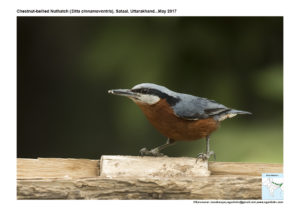
Chestnut-bellied Nuthatch Sitta cinnamoventris
Etymology:
- Sitta : Greek word for a bird like a woodpecker
- Cinnamoventris : Latin word cinnamum- cinnamon; ventris –belly { Cinnamon coloured belly}
Distribution in India: Resident of foothills of Himalayas and North East hills in India.
Description: Size of 13–14 cm; wt. of 17·4–20·9 g . It is a medium-sized nuthatch with long, deep, broad-tipped bill. The male of nominate race has dark blue-grey crown, upperparts, lesser and median upperwing-coverts. The extreme base of bill and lores are blackish, extending into black eyestripe which expands broadly on side of mantle. The greater secondary coverts, primary coverts and alula are dark grey, fringed and tipped blue-grey. The tertials are blackish on inner web and blue-grey on outer web, flight-feathers are dark grey-brown. The secondaries and inner primaries broadly fringed blue-grey and central tail feathers are blue-grey. The outer feathers are blackish, broadly fringed dull blue-grey on outer web and tip of inner web, outer two feather pairs with large white subterminal spot on inner web, T4 with small whitish tip on inner web. The cheek and fore ear-coverts are white, feathers sometimes faintly tipped darker. The rear ear-coverts, side of neck and underparts are dark chestnut-brown. The undertail-coverts are greyish with broad white subterminal band and fine chestnut fringes. The thigh feathers are grey with blue-grey subterminal band and chestnut-brown tip. The axillaries are blue-grey, tipped orange-brown, underwing-coverts are sooty black, longer under primary coverts and base of primaries are white. The iris is reddish-brown to dark brown; bill is black, variable blue-grey at base of culmen, cutting edges and lower mandible; legs are slaty horn and soles are grey-white to white. The female is like male, but chin, cheek and fore ear-coverts off-white, sometimes with faint dark barring, underparts are paler and more cinnamon, slightly darker on lower belly.
Habitat: It is found in open deciduous forest, light forest formations, scattered trees, mango groves, bamboo clumps etc. Found from 200 m to 2200 m.
Food habits: It eats insects, seeds and nuts. It is found singly, more often in pairs and frequently joins mixed-species foraging flocks. It forages on trunk and larger boughs, also among smaller branches and twigs. It sometimes feeds on ground looking for termites.
Breeding habits: They breed in Apr–May in Himalayan foothills and North East India. The nest is a layer of moss or bark fragments, with a few dried leaves, lined with pad of fur, placed in natural cavity in tree, cavity in wall or steep bank preferred. The entrance hole of nest is reduced with mud “masonry” . The nest be reused in successive years. They lay a clutch of 5–7 eggs.